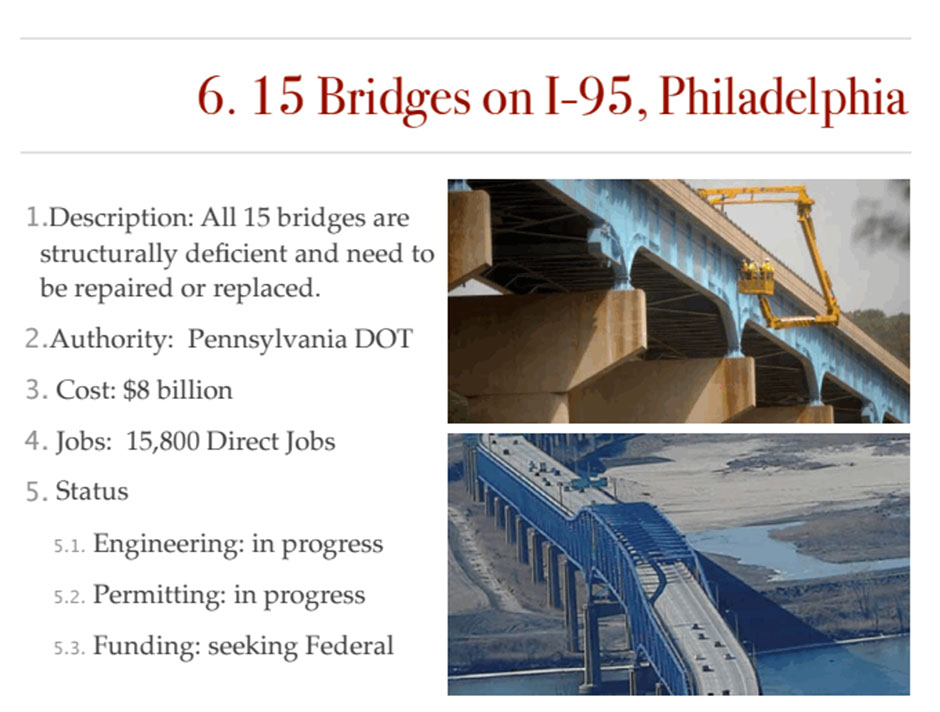Does President Trump Want to Put Tolls on I-95?

An excerpt from Trump’s Emergency & National Security Projects “priority list” obtained by McClatchy newspapers
Is Donald Trump going to put tolls on I-95?
The backstory: Yesterday, reporters at the Kansas City Star and McClatchy’s D.C. bureau published Donald Trump’s infrastructure “priority list.” The document, which McClatchy says has “circulated within the congressional and business communities,” comprises around 50 infrastructure and national security projects around the country.
I-95 in Philadelphia is on the list. The document says the administration wants to replace/rebuild 15 bridges on 95 in the city. Of course, anyone who’s driven 95 in the last few years knows that the highway has already been under construction between Cottman and Girard avenues. (The work at Cottman finished last year.)
So perhaps 95 will get new bridges. But here’s the rub: Trump’s infrastructure plan relies heavily on private-public partnerships, or P3s. But in order to get private investment in a public infrastructure project, there has to be some sort of revenue stream. “In the highway community,” Pat Jones, CEO of the International Bridge, Tunnel and Turnpike Association, told Pew last year, “private investment means toll roads.”
Following the logic: Donald Trump’s infrastructure plan as stated would put tolls on I-95.
The White House didn’t return a request for comment from Philadelphia magazine. But it’s useful to note possible caveats: The McClatchy report notes this is similar to a list the National Governor’s Association recently put together. As PlanPhilly’s Jim Saksa tweeted: “I don’t think it’s a real list. More like projects the governors like.” As president, and in his career as a private developer, Trump has long said whatever the hell he’s thinking at the moment without thinking it through. So who knows.
But tolling 95 has been tried before: Former state Rep. Rick Geist, a 17-term legislator until he was defeated by a Tea Party Republican in the 2012 primary, suggested tolling I-95 in 2011 as a way to fund the rebuilding of the highway. His plan called for tolling three of the lanes, but leaving a free fourth lane for drivers who didn’t want to pay. “You will still have the opportunity to park on I-95,” he said.
Any move to toll I-95 would have to be approved by the Federal Highway Administration, but Trump controls the government now. When federal officials rejected the state’s plan to toll I-80 about a decade ago — reportedly because the money would be spread around the state — several politicians floated plans to toll I-95 instead. Former state Rep. Russ Fairchild wrote in 2007: “If they feel they need money to help bail out SEPTA in Philadelphia, then they should toll I-95.” (Congress may need to approve tolling I-95, but that would likely be part of a hypothetical massive infrastructure bill.)
And former U.S. Rep. Chaka Fattah, who left office after he was convicted of corruption charges, floated a “congestion charge” for drivers coming into Center City when he was running for mayor in 2007. He quickly dropped the plan after an outcry. Former Speaker of the House John Perzel, another former lawmaker convicted of corruption, also wanted to toll I-95.
Presumably, a tolling option on I-95 would not include toll booths. Last year, the Pennsylvania Turnpike instituted cashless tolling on the Delaware River-Turnpike Bridge. If you don’t have an E-ZPass, the state scans your license plate and sends you a bill. (Yes, that bridge is now closed after a crack was found. But this infrastructure plan would fund improvements to bridges, or even new bridges altogether, which in theory would not crack.)
Either way, if Trump wants private money to fund any repairs or reconstruction of I-95, there would have to be tolls on the road. Have fun paying to come into Center City, everyone!